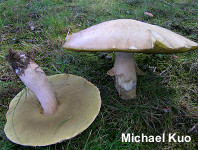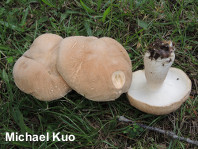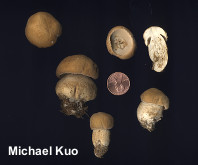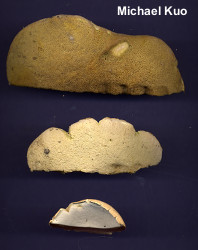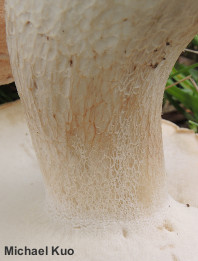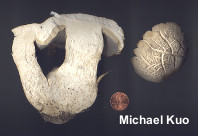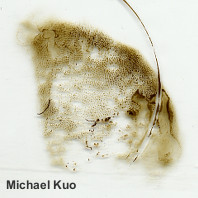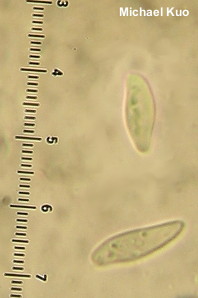| Major Groups > Boletes > Edulis Group > Boletus cf. reticulatus |

|
Boletus cf. reticulatus [ Basidiomycota > Boletales > Boletaceae > Boletus . . . ] by Michael Kuo This eastern member of the Boletus edulis group is one of only a few in the group occurring under eastern hardwoods in the summer. The others include Boletus atkinsonii, with a yellowish brown cap that turns purple with ammonia, and Boletus separans, with a liver red cap (when young, at least) that turns green with ammonia. Boletus cf. reticulatus, by contrast, has a pale to dark brown cap that turns a boring orangish tan with ammonia. I am using the mycological convention "cf" (explained here) because the mushroom I'm describing is very similar to Europe's oak-loving summer edulis-like species, Boletus reticulatus (also known as Boletus aestivalis)--but it may well be different, since it occurs on another continent. In fact a preliminary DNA study of this mushroom by Swedish and British scientists in 2004 (unpublished) indicated genetic affinity—but not conspecificity—with European Boletus reticulatus/aestivalis collections for the species illustrated here. I find the illustrated species regularly in central Illinois, under oak and hickory, from late May to August. In one location it reappears consistently each summer, and has done so regularly over a period of about ten years. In dry years, one or two will appear; in wet years I have collected many. Several eastern North American authors describe a very similar, summer fruiting, hardwood-loving species—as Boletus reticulatus (Bessette, Roody & Bessette, 2000) and as Boletus edulis subsp. reticulatus (Snell & Dick, 1970). These descriptions agree with the mushroom described here in most respects, but involve much darker browns on the cap and stem. Description: Ecology: Apparently mycorrhizal with oaks, especially white oak; growing scattered or gregariously (occasionally clustered); late May to August; Douglas and Lawrence Counties, Illinois. Cap: 7–18 cm, convex in the button stage, expanding to broadly convex in age; dry; with the texture of well-worn leather; more or less smooth, but often breaking up and developing deep and prominent cracks; whitish to pale brown, becoming brownish to pale brown or yellow-brown in age; not bruising or discoloring; the margin inrolled when young, splitting with age, typically without a sterile projection. Pore Surface: Whitish to dirty gray when young; becoming pale buff, then olive, then brownish; young pore surface bruising ochraceous to brownish (a sort of watery and darker version of the pore surface color) and older surfaces bruising brownish or not bruising; the pores "stuffed" until the mushroom is quite old; tubes colored like the pore surface, extending to 12 mm deep; eventually receding from the stem. Stem: 4–10 cm long; 2–4 cm. thick; swollen and club-shaped when young, becoming club-shaped or more or less equal; finely reticulate (over the whole stem or, more often, only near the apex); the reticulation typically white but occasionally brownish; often developing fissures and "peeling" sections; whitish; sometimes appearing to stain brownish when handled; solid. Flesh: White; thick throughout; not staining on exposure. Odor and Taste: Pleasant, but not distinctive. Chemical Reactions: Ammonia negative to orangish tan on cap surface; negative on flesh. KOH negative to orangish tan on cap surface; negative on flesh. Iron salts negative on cap surface; negative on flesh. Spore Print: Olive brown. Microscopic Features: Spores 10-15 x 3-4.5 µm; smooth; subfusiform. Pileipellis a collapsing trichoderm; elements 2.5–7.5 µm wide, smooth, yellowish in KOH; terminal cells cylindric with rounded to subacute apices. REFERENCES: (Saccardo, 1888; Snell & Dick, 1970; Breitenbach & Kränzlin, 1991; Hansen & Knudsen, 1992; Bessette, Roody & Bessette, 2000; Kuo, 2007 ["Boletus sp."]; Kuo & Methven, 2014.) Herb. Kuo 06269601, 06210201, 07220319, 05250402. This site contains no information about the edibility or toxicity of mushrooms. |
© MushroomExpert.Com |
|
Cite this page as: Kuo, M. (2017, September). Boletus cf. reticulatus. Retrieved from the MushroomExpert.Com Web site: http://www.mushroomexpert.com/boletus_cf_reticulatus.html |
